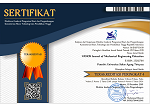Analysis of the Effect of Blade Thickness on Propeller Water Turbine Performance Using Computational Fluid Dynamic
Abstract
Hydropower on the lowest scale namely propeller pico-hydro, the turbine has a light workload so that allows it to be made from polymer materials with rapid manufacturing 3D printing technology. In the design of the propeller turbine, the most concerned loading is the axial load which results in failure. A failure of designing the dimensions of the propeller turbine with polymer materials causes a fracture in the blades. This study aims to analyze how the effect of blade thickness on the performance of a propeller water turbine. Data collection in this study uses numerical simulation through computational fluid dynamics using SolidWorks Flow Simulation with the blade thickness variable used 1 mm to 3 mm with a fillet size 1.5 mm. Based on the results, the thickness of the blade affects the value of static torque. At a blade thickness of 2 mm, it shows the most optimal torque value compared to a thickness value below or above 2 mm.
Keywords
Full Text:
PDFReferences
Brijkishore, Khare, R. and Prasad, V. (2020) ‘Performance Evaluation of Kaplan Turbine with Different Runner Solidity Using CFD’, Advances in Intelligent Systems and Computing. Edited by R. V. Rao and J. Taler. Springer Nature Singapore Pte Ltd, 949, pp. 757–767. doi: https://doi.org/10.1007/978-981-13-8196-6_67.
Darsono, F. B., Nurdin, A. and Widodo, R. D. (2021) ‘Studi Modifikasi Geometri Sudu pada Turbin Air Propeller Menggunakan Metode Elemen Hingga’, Jurnal Rekayasa Mesin, 16(3), pp. 311–318.
Darsono, F. B., Widodo, R. D. and Nurdin, A. (2022) ‘Analysis Of the Effect of Flow Rate and Speed on Four Blade Tubular Water Bulb-Turbine Efficiency Using Numerical Flow Simulation’, Journal of Advanced Research in Fluid Mechanics and Thermal Sciences, 2(2), pp. 1–8.
Himawanto, D. A., Nurdin, A. and Bisri, H. (2021) ‘Studi Eksperimental Pengaruh Jumlah Sudu terhadap Unjuk Kerja Pico Bulb Turbine Aliran Horisontal’, Jurnal Teknik, 42(2), pp. 236–240. doi: 10.14710/teknik.
Ho-Yan, B. (2012) Design of a Low Head Pico Hydro Turbine for Rural Electrification in Cameroon. The University of Guelph. Available at: https://atrium.lib.uoguelph.ca/xmlui/handle/10214/3552.
Nurdin, A., Hadi, S. and Himawanto, D. A. (2020) ‘Optimasi perancangan turbin air axial aliran horisontal menggunakan analysis of variance Optimasi perancangan turbin air menggunakan analysis of variance aliran horisontal’, Dinamika Teknik Mesin, 10(October), pp. 103–109. doi: 10.29303/dtm.v10i2.329.
Nurdin, A., Himawanto, D. A. and Hadi, S. (2020a) ‘Study of the Effect of Bulb Ratio and Blade Angle on Propeller Turbine Performance in Horizontal Flow using Numerical Simulation’, Jurnal Teknik, 41(1), pp. 9–13.
Nurdin, A., Himawanto, D. A. and Hadi, S. (2020b) ‘The Utilization Of Horizontal Pipeline For a Static Bulb Turbine and The Determination of Optimum Blade Number’, Ketenagalistrikan dan Energi Terbarukan, 18(2), pp. 61–68.
Nurdin, A., Himawanto, D. A. and Hadi, S. (2021) ‘Iranian ( Iranica ) Journal of Energy & Environment Utilization of Horizontal Water System as Electrical Power Generation in Pico Scale with a Small Bulb Turbine’, Iranian (Iranica) Journal of Energy and Environment, 12(3), pp. 220–225. doi: 10.5829/ijee.2021.12.03.06.
Ramos, H. M., Simão, M. and Borga, A. (2013) ‘Experiments and CFD Analyses for a New Reaction Microhydro Propeller with Five Blades’, Journal of Energy Engineering, 139(2), pp. 109–117. doi: 10.1061/(ASCE)EY.1943-7897.0000096.
Ratnaningsih, A., Hasanuddin, A. and Hermansa, R. (2014) ‘Penilaian Kriteria Green Building Pada Pembangunan Gedung IsDB Project Berdasarkan Skala Indeks Menggunakan Greenship Versi 1 . 2 ( Studi Kasus : Gedung Engineering Biotechnology Universitas Jember )’, Berkala Sainstek, 7(2), pp. 59–66.
Supraba, A. Z. et al. (2016) ‘Redesign runner turbin pembangkit listrik tenaga pico hydro dengan metode reverse engineering melalui pendekatan teoritis’, JTMI, 12(2), pp. 61–65.
DOI: http://dx.doi.org/10.30870/vanos.v7i1.14979
Refbacks
- There are currently no refbacks.

This work is licensed under a Creative Commons Attribution 4.0 International License.


.png)
.png)
